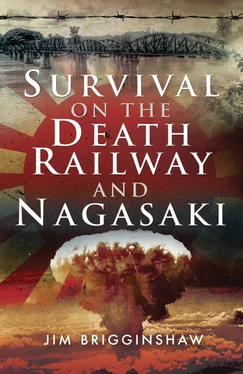The two Australians later confided to their mates that when they were out of sight of the Japanese on the bridge, they made sure the engineer wouldn’t be coming back with them.
One day, a Lockheed Lightning twin-tailed fighter-reconnaissance aircraft buzzed the prisoners at the Hundred and Five-Kilo camp. The Allied plane flew quickly over the men, came back for a second look, and then flew off. That night, planes could be heard flying east in the direction of Siam.
At about nine o’clock, the prisoners heard a phone ring in the Korean guardhouse. The Korean voice that answered, sleepily at first, grew agitated. The men heard the word ‘hikooki’ (aeroplane) and took it to be a warning that bombers were on the way to attack.
The Koreans panicked, left the guardhouse and ran down the prisoners’ camp lines shouting, ‘Hikooki! Hikooki!’
However, it was a false alarm. There was no aerial attack, and the men decided it was probably a bombing raid down the coast. Nevertheless, the prisoners gained some satisfaction from seeing how the Koreans reacted in an emergency.
During another air raid scare one night, the Korean guards fled blindly though the Australians’ lines, keen to get as far away from the railway as possible. The prisoners were delighted when one of the guards fell into a latrine trench and had to be fished out.
His smelly discomfort provided them with a happy moment.
Escape was always on everyone’s mind, but there was no chance of it happening. When Japanese Colonel Nagatomo told the prisoners at Thambuzyat at the start of the Burma Railway that escape was impossible, he wasn’t exaggerating.
As he said, potential escapees would see boundless oceans to the west, impenetrable jungle to the north and Japanese forces to the east and south. Prisoners whose stamina had been destroyed by slavery, starvation and disease would have no chance.
Burma had a large proportion of pro-British people, but there were also many bounty hunters ever willing to hand over escapees to the Japanese for the price on their heads.
The prisoners quickly learnt that their best chance of survival was to stay together and trust in providence.
Before A-Force arrived at Thambuzyat, a group of British POWs had tried to escape, but had all finished up in Thambuzyat cemetery.
At the Twenty-six-Kilo camp, three prisoners, Captain Mull, Sergeant Dickenson and Private Bell, had made a break for freedom, heading north towards Moulmein. All three had worked in Burma before the war and knew the area and its conditions.
Dickenson didn’t last long. Badly debilitated from malaria, he gave himself up. He was taken back to Thambuzyat and executed.
Mull and Bell continued north, moving by night and hiding during the day. They evaded Japanese forces by following the Salween River but ran into a patrol of Burmese police. The escapees had no weapons, apart from an old pistol Mull had been able to obtain from somewhere. Regardless, they elected to fight.
Mull was shot dead, while Bell, who was seriously wounded, was taken back to Thambuzyat and executed.
These were the only recorded escape attempts, although prisoners caught outside a compound fence scrounging for food were also treated as escapees.
Once the men left Thambuzyat and started building the railway line, the camps weren’t regarded as permanent, and no fences were erected. Without anything to stop them, the men could walk into the jungle when they weren’t working, but the hostile jungle was enough to curb any desire to wander too far from the camp.
Dysentery was so widespread by the time the men reached the Hundred and Five-Kilo camp that the Japanese swabbed all the railway workers, including conscripted civilian natives, to find out how many prisoners had the disease. The swabs must have shown that thousands were riddled with dysentery, but not one person received treatment.
The swabbing was an exercise in cruelty. Prisoners were ordered to remove their trousers, if they had any, bend over and spread their legs. Then, a Japanese would insert a length of heavy-gauge galvanised wire with a hook on the end and take a sample of faeces.
Even this inhuman method couldn’t destroy the Australians’ ability to make fun of even the most serious situations. One prisoner pretended to join the line again for a second testing, saying he’d enjoyed it so much he wanted to back up.
The swabbing included female Burmese civilian workers. They were separated from the prisoners’ compound by a high bamboo fence, but the many gaps in the fence allowed the men to witness the testing of the women.
As the men watched, one of the women gave a yell when the wire was inserted and bounded off, the wire wagging behind her like a tail.
‘Told you the Nips can’t aim straight’, an Australian said.
The Japanese decided to make a propaganda film at the Hundred and Five-Kilo camp to show how well they were treating their prisoners of war. It was a move to counter reports of Japanese atrocities that were filtering through to the outside world.
Before filming began, the prisoners were ordered to clean up the camp. This done, tables were set up and spread with tablecloths, decorated with vases of flowers and laid out with good quality cups, saucers and plates. Fruit and cakes were heaped onto the plates. The prisoners had almost forgotten what fruit and cakes looked like.
The few who were to appear in the film were given clothes. Dressed in these, they were filmed marching out of the camp on a pretend work party. Ordered to sing a happy Australian song as they marched to show how much they were enjoying themselves, they sang Fuck ’em All, the camp version of Bless ’em All.
As soon as the film crew left, the clothes the prisoners had worn were taken back, as were the fruit and cakes.
When interpreters revealed what the happy Australian marchers had been singing, punishments were handed out and all Australian songs became suspect, so it was a surprise when the Japanese agreed to let the prisoners hold a camp concert.
One of the stage props for the performance was a wireless set, its cabinet highly polished and beautifully crafted by the prisoners. Finding the materials to make it had involved scrounging of the highest order.
The concert got under way with the disappointing announcement that star performer Bob Skelton, a talented baritone from Victoria, had been operated on for appendicitis and was in the camp hospital, unable to perform.
When it came to Skelton’s scheduled spot on the program, stagehands fiddled with the knobs on the wireless cabinet. From it, softly at first, and then gradually increasing in volume, came Skelton’s magnificent voice singing Begin the Beguine.
The audience couldn’t believe it. Bob must be broadcasting from the hospital. How did the Japanese allow that?
However, Skelton wasn’t in hospital. He’d left his bed to sing from a hiding place under the dummy wireless cabinet.
The illusion was incredible. No surviving member of that audience ever forgot the magical moment.
The Japanese and Korean guards were also fooled. Having a wireless was one of the more serious crimes the prisoners could commit, and the guards turned this one inside out before they finally accepted that it wasn’t the real thing, only a shell.
Skelton’s performance was countered by the Japanese producing a singer of their own, a senior officer who tried to outdo the Australian. In a squeaky sing-song voice, he presented a dramatic, drawn-out vocal version of ancient Japanese battles between warlords.
It was terrible, but when he wound up on a note that sounded like the factory knock-off whistle, the prisoners clapped, stamped, cheered and demanded an encore.
The Japanese officer bowed, took it as a signal of appreciation of his talent and was happy to give the audience more. Each time he finished, the prisoners called for still more. It was top entertainment seeing him making a fool of himself, bounding about the stage cutting and thrusting with his sword at make-believe foes, bellowing and grunting like a stuck pig.
Читать дальше












